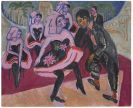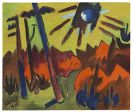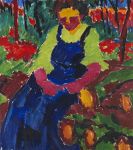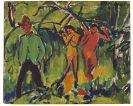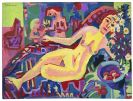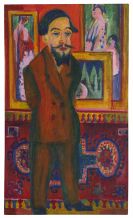
Ludwig Meidner
Bernstadt/Schlesien
1884 -
Darmstadt
1966
Following his parents' wishes the young Ludwig Meidner began an apprenticeship as a stone mason, which he did not finish. Instead he was admitted to the Breslau "Kunst- und Kunstgewerbeschule". Two and a half years later he left the school and moved to Berlin. The instructions he received in etching from artist Hermann Struck were important for Meidner's later work. He did only few paintings during his early Berlin years, such as the "Industrial Urban Landscapes", which formally and in the pallette resembled the work of the French Fauves. Ludwig Meidner was not interested in the aesthetics of architecture, instead his interest lay in the agressive suppression of nature by the expanding metropolis, which he describes as being menacing and eerie.
In 1906 Ludwig Meidner went to Paris for just under a year, where he met Amedeo Modigliani. The following years in Berlin saw Meidner haunted by dire financial straits. His favorite models were his friends who were writers. The year 1912 was important for the artist: He painted the first of his compelling self-protraits and "Apocalyptic Landscapes" and joined forces with Jacob Steinhardt and Richard Janthur to found "Die Pathetiker", a group that showed their works at "Der Sturm", Herwarth Walden's gallery.
There Meidner met Robert Delaunay, whose Orphic way of painting inspired him as much as the art work of the Italian Futurists. Plagued by existential fears, he turned to painting religious themes. In 1916 Meidner was conscripted to the military, where he served as interpreter and censor at an internment camp for prisoners of war. There he began to write.
After the war in 1918 Ludwig Meidner joined the "Novembergruppe" and the revolutionary "Arbeitsrat für Kunst".
Disappointed at the failure of the revolution, he retired to nurse his disillusionment in private.
He abandoned Expressionism, which by then was so popular that its commercial outlook increasingly brightened. In "Autobiographische Plauderei" he offended companions and friends by repudiating his early work. Henceforth his works were dominated by religious themes, landscapes, still lives and more portraits.
Denounced as "degenerate" and persecuted because he was a Jew, Ludwig Meidner emigrated to England in 1933, not returning to Germany before 1953.
In a last, very productive creative phase, he further developed the style of painterly realism he had developed in the 1920s.
Would you like to sell a work by Ludwig Meidner?
Infos for seller

